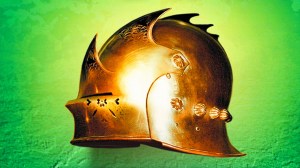It’s 1966. An angel and a telepath are casually eating pizza on a street corner. The angel worries they will miss seeing The Lovin’ Spoonful play live if they don’t hurry. The telepath asserts that the ethical thing for them to do would be to take over the world. This is The Power Fantasy #1 from the reunited Peter Cannon: Thunderbolt team of writer Kieron Gillen and artist Caspar Wijngaard, an introduction to an alternate reality where the dawn of the nuclear age also heralded, not coincidentally, the age of “superpowers,” a term now specifically used for a handful of beings who each possess the destructive power of a nuclear arsenal.
Videos by ComicBook.com
The most powerful people to have existed ever discussing world domination over a slice is perfectly emblematic of the dissonance at the heart of The Power Fantasy‘s premise. How do the mundane, the fun, and the beautiful continue to exist in the shadow of all-powerful beings who could turn everything to dust on a whim or when losing their temper? Except that’s not a fantasy. That’s how we live every day, in the shadow of billionaires, tyrants, and the military-industrial complex.
One could label The Power Fantasy as a thinking person’s superhero comic. Gillen’s penchants for irony and wordplay are on full display, leveraging the double meanings of words like “superpowers” (i.e. The fantastical abilities, or the entities upon which the axes of political power swivel?) and the very notion of a power fantasy (i.e. It’s clear early that The Power Fantasy is not a comic book for escapist wish fulfillment but deconstructing notions of power and how it is wielded).
The entire first issue follows Etienne Lux, the telepath from the opening sequence. The Power Fantasy was born of ideas Gillen had while working on the X-Men during the second half of the Krakoan era. In that light, it’s easy to see Etienne as being loosely inspired by (though crucially, not analogous to) Professor X. During his time writing Immortal X-Men, X-Men Forever, and Rise of the Powers of X, Gillen continually challenged the notion that Professor X is a good man, pushing the question of what awful things such a person who is that comfortable in his power and entirely certain of his righteousness might do, unchecked, to achieve what he considers the morally correct ends.
That interrogation continues in Etienne who, unlike Professor X, is all about keeping power in check. Knowing that any battle between the superpowers would undoubtedly lead to mass extinction, Etienne has seemingly memorized the writings of all the great ethical philosophers, wielding their teachings like variables in an equation he has written to solve for right and wrong. And yet, his tense conversation with the book’s angel, Valentina, and his tendency to speak is qualified, realpolitik-accented doublespeak (the right to live should be extended to “as many people as possible,” “lying unnecessarily is unethical”) is unnerving, hinting that a more practical realist lurks beneath his benign and erudite demeanor, one who has the power to commit mass violence with a mere thought.
Yes, The Power Fantasy could be described as a thinking person’s superhero comic that walks in the footsteps of works like Watchmen (which may come off as somewhat ironic to anyone who has read Gillen and Wijngaard’s Peter Cannon: Thunderbolt). However, it is also a comic book for anyone who might enjoy seeing a superpowered hippy be incinerated by an orbital laser only to mend himself back together again in the aftermath.
With The Power Fantasy, Wijngaard has reined in some of the raucous energy of his most recent work, the weathered anarchy of Home Sick Pilots and brutal savagery of All Against All. It’s still recognizable as his artwork, but more focused and controlled, with some of his sharpest linework. It’s a visual style that fits a story where every violent action could mean the end of life. When violence does occur and the delicate balance of power comes precariously close to tipping, offering Wijngaard the opportunity to tap into the controlled chaos of some of his previous work, it makes those moments—such as when a man’s insides are burning away like the flickering of paper turning to ash—that much more arresting.
Superhero fans love to ask which hero would win in a fight against another of their kind if they ever came to blows. With The Power Fantasy, Gillen and Wijngaard suggest the answer is that no one would be left alive to declare a victor. It is a world that ups Watchmen‘s Cold War game by multiplying the threat of Doctor Manhattan by six and balancing humanity’s continued existence on their ability to self-police. The Power Fantasy #1 begins in 1966 with Etienne sharing pizza with an angel. It ends in 1999, with Etienne cutting an interview short, having committed multiple ethically correct murders before lunchtime. On the final page, depicting Etienne walking away, blank white negative space creeps up from the bottom right-hand corner, as if hinting at things already beginning to come apart.
By the end of The Power Fantasy #1, the reader is left with the impression they’re waiting for a bomb to go off. Or perhaps six of them. It’s intense, yet understated, and gripping. Ripe with the potential for drama, intrigue, nuance, depth, and meaning, The Power Fantasy is primed to explode superhero comics.
Published by Image Comics
On August 7, 2024
Written by Kieron Gillen
Art by Caspar Wijngaard
Colors by Caspar Wijngaard
Letters by Clayton Cowles
Cover by Caspar Wijngaard








